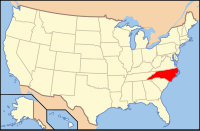Cherokee County, North Carolina
| Cherokee County, North Carolina | |
|---|---|

|
|
 Location in the U.S. state of North Carolina |
|
 North Carolina's location in the U.S. |
|
| Founded | 1839 |
| Named for | Cherokee people |
| Seat | Murphy |
| Largest town | Andrews |
| Area | |
| • Total | 467 sq mi (1,210 km2) |
| • Land | 455 sq mi (1,178 km2) |
| • Water | 11 sq mi (28 km2), 2.4% |
| Population | |
| • (2010) | 27,444 |
| • Density | 60/sq mi (23/km²) |
| Congressional district | 11th |
| Time zone | Eastern: UTC-5/-4 |
| Website | www |
Cherokee County is the westernmost county in the U.S. state of North Carolina. As of the 2010 census, the population was 27,444. Its county seat is Murphy.
The county was formed in 1839 from the western part of Macon County. It was named for the Cherokee Native Americans, some of whom still live in the area.
In 1861 the southeastern part of Cherokee County became Clay County. In 1872 its northeastern part was also separated and became Graham County.
Cherokee County is a member of the regional Southwestern Commission council of governments.
According to the U.S. Census Bureau, the county has a total area of 467 square miles (1,210 km2), of which 455 square miles (1,180 km2) is land and 11 square miles (28 km2) (2.4%) is water.
Located in the southern Appalachian Mountains, Cherokee County contains a varied natural landscape. Portions of the county fall within the boundaries of the Nantahala National Forest, and the Hiawassee River - a tributary of the Tennessee River - flows through the county from southeast to northwest.
In April 1974, parts of Cherokee County were affected by a historic weather event - the 1974 Super Outbreak of tornadoes, which affected parts of 13 states and was the second-largest such event to be recorded in the U.S.
...
Wikipedia
